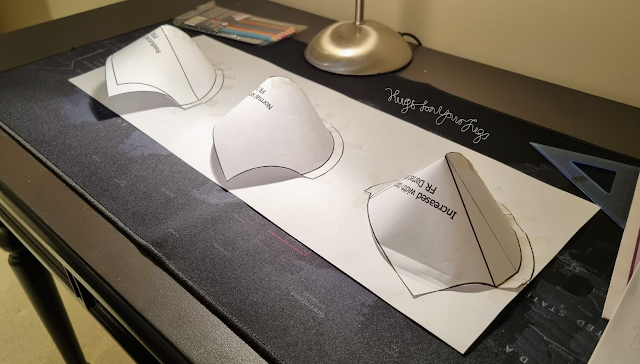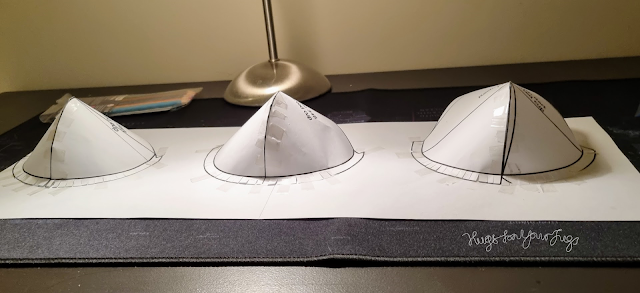What is the effect of changing the dart width in a bra cup pattern?
This question caused a lot of intrigue on Instagram when I asked it, and it's a question that has confused me as well for a long time. Analysing this alteration and its effects has really improved my overall understanding of bra cup geometry, so even if you don't intend to wear darted cup bras, I would still recommend reading through this post to help understand other alterations.
An extended version of this post can be found on my Ko-fi,
where you can get instant access to this and previous extended blog
posts for just £2. If you want, you can become a member for £2 a month
to continue supporting my blog.
I drew up a Foundations Revealed draft of a darted cup bra. It's possible to maintain all the internal cup radiuses and wireline lengths while altering the dart angle, shown below to make it both narrower and wider. When we widen the dart, the whole bra seems to shift upwards. What happens to the fit, though?
 |
| Same pattern, changed dart width |
There were all manner of different answers to this question - although (at the time of writing) no one got it exactly correct. Let's examine the more popular responses to see if they hold water:
1. A move in the apex position?
The apex position in a bra is determined by the internal radiuses of the cup. If the cup is closer to one wireline than another, the apex will have moved. As all of these have the same internal radiuses, the apex remains in the same position.
 |
| Each line of matching colour is the same length |
2. Increased projection/pointiness?
This is probably the most common suggestion. It comes from the idea that if you take a cone and reduce the length of the arc, the resultant cone will be taller. Notably, the "base circle" will also become smaller. |
| While the bottom triangle is more projected, its base circle is smaller |
However, this does not happen in this bra because we are using a wire, and maintaining all wireline lengths. This wire fixes the "base circle", so this cannot become smaller. So the only way to increase the projection of a cone with a fixed circle would be to increase the radius of your sector. As we've already seen, this hasn't happened.
3. A change to the lower cup - BCD, lift, etc?
Although it looks like a big change has happened to the lower cup, nothing at all has happened here. In the next section, I'll show exactly how we can tell without having to sew up the cups.
What does happen, then?
Here are some paper models showing what's happened to each bra when the dart seam is taped up and the cup is affixed to a wireline.
We can see that there's no difference in the projection of the cup.
The apex hasn't moved. In fact, the lower cups on all three are identical.
The only difference is the upper cup. The wider darted bra has a more closed off neckline, narrower darted one has a more open neckline.*
 |
| I had to fold the neckline of the most closed off cup so it would sit on the paper. |
Let's take a look at the pattern to examine why.
If we take the original pattern, we can "match it up" to the wireline seam of the cradle. We can do this with the new patterns too - remember that the wireline seams didn't change at all there.
 |
| Please ignore minor changes in the curves - these are drawing errors. |
If we inspect the triangles made by drawing lines from the wireline to the apex, we can see that they're the exact same! We can orientate the pattern pieces any way we want to on paper, but because they're anchored in place by the unchanging wireline, they end up the same way in the bra.
The thing that has changed though, is the neckline. The easiest way to think about this alteration is to not think about the dart at all, but to think about the knock-on effect of the dart on other areas of the cup. If we slice up the pattern and widen the dart, in the manner of traditional pattern alteration, we can clearly see we're narrowing the neckline. And vice versa, of course.
 |
| Darting/wedging the neckline reproduces this alteration, so we can see that the neckline's openness is the only resultant change. |
We can see this in the drafting process as well - when drafting, to keep the internal radius from the apex to the strap attachment we must change the length of the neckline and armpit edges.
The lesson to be learned here is to always think about the bra in terms of its radial geometry - alterations about the apex and wireline - rather than changes in the x and y dimensions.
In the extended edition
of this post, I go a step further and investigate: what if we widen the dart, but then attempt to correct for the neckline being narrowed?
If you liked this post, be sure to follow me for email updates whenever I post a new one! If you really liked this post, donate to my Ko-fi for extra content!
*In a way, I suppose the cup is "more pointy", it's just showing it in a different way to how most people expect.




Comments
Post a Comment